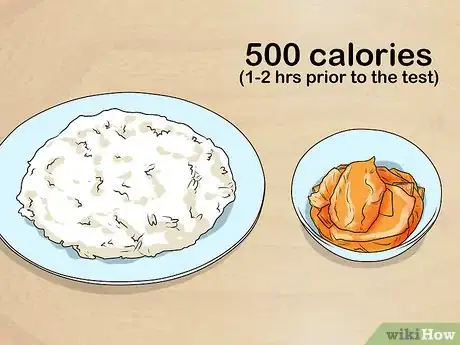This article was co-authored by Paige Bowen, MA, EdM. Paige Bowen is a Physical Education Teacher at Oconee County Primary School in Watkinsville, Georgia. Paige has over 20 years of physical education teaching experience. She was awarded the Oconee County Primary School Teacher of the Year for 2002-2003. She received a B.S.Ed. in Health and Physical Education from the University of Georgia in 1996 and an M.Ed. in Early Childhood Education in 2003 from the same institution.
There are 7 references cited in this article, which can be found at the bottom of the page.
wikiHow marks an article as reader-approved once it receives enough positive feedback. In this case, 82% of readers who voted found the article helpful, earning it our reader-approved status.
This article has been viewed 159,068 times.
The beep test might seem intimidating. But surviving the beep test is no problem if you’re prepared. Remember to turn, breathe, and rest during the test. Additionally, improve your overall level of physical fitness and adopt a positive attitude to help you conquer the PACER with no problems.
Steps
Tackling the Test
-
1Adopt a strong mental attitude. Even people who are physically capable of surviving the PACER test might not simply because they don't believe that they can. In short, a negative attitude can actually prevent you from passing. Adopting an attitude of perseverance and confidence, however, will enable you to survive the test.
- When you begin to feel winded, tell yourself, “I can survive the PACER test. I will not quit.”
-
2Remember that the PACER test is not a race. All you need to do to conquer the beep test is to beat the timer and arrive on the opposite side before it sounds for the second time. Don’t try to get there first, and don’t let yourself be discouraged if the other test participants are getting to the opposite side faster than you.[1]
- If you think of the test as a race, you'll push yourself too hard in the beginning. This may leave you too tired to actually finish. As the name implies, you have to pace yourself.
Advertisement -
3Go as slow as possible at each stage. Avoid getting tired quickly by jogging instead of sprinting. After you’ve practiced the test a few times, you’ll know how much time there is between the beeps at each level of the test.[2]
- Make sure you get to the line before the beep, however!
-
4Breathe in through your nose and out through your mouth while you run. Make sure you're breathing from your belly and not through your chest. Keep your breathing steady by counting to 2 as you breathe in and 2 as you breathe out.[3]
- Try practicing breathing like this before you start running. Do it while standing. Once you get the hang on it, try doing it while walking, then jogging, then running.
-
5Avoid sitting down between beeps. The act of standing up requires an extra expense of energy. Instead, rest while standing, and focus on breathing deeply.[4]
- When you reach the opposite side, stop immediately and turn on the ball of your foot so you're ready for the next beep.
- Some people like to alternate the foot they use to step on (or just over) the end-line. This can keep your mind occupied and enhance your focus during the test.
-
6Distinguish between the triple beep and single beep. The single beep is a sign that you should run to the opposite side. The triple beep doesn't require you to move, but rather indicates that the test is going to increase in intensity.[5]
- Remember, if you’ve not arrived at the opposite side and the second single beep sounds, you’ll need to return to where you started from.
Taking Action Before the Test
-
1Get enough sleep the night before. Teens should get 8 to 10 hours of sleep each night. Adults should get about 7 to 9 hours of sleep each night.[6] With adequate rest, you’ll be prepared to survive the PACER test.
- If you're having trouble sleeping, try doing some meditation or drinking an herbal tea, such as chamomile.
- Avoid using electronics at least 1 hour before bedtime. The bright screen will indicate to your brain that it's time to wake up, which'll prevent you from sleeping.
-
2Eat a light meal 1 or 2 hours prior to the test. A healthy, light meal will give you the energy you need to survive the PACER test. There are many such meals. For instance, you might eat a bowl of beans and rice with a side of kimchi. Or you could eat lentil soup and a salad topped with Italian dressing.
- Keep your meal fewer than 500 calories.
-
3Warm up for 5 to 10 minutes before the test. Roll your neck and shoulders forward and backward, twist and turn at the hips, and/or reach down and touch your toes several times.
- Depending on which PACER test audio track you’re listening to, you also might be told to warm up at regular intervals during the test. Take advantage of these opportunities to warm up.
- Even if you’re participating in a PACER test with audio that doesn’t encourage you to warm up between runs, do so anyways.
-
4Drink a cup of water before the test. Staying hydrated is important when running. You will obviously not be able to grab water in between laps, so right before the test, take a drink of water. Not so much where you need to use the bathroom, but enough to keep you hydrated.
- After the test, grab a drink of water immediately.
Achieving Physical Fitness
-
1Look for opportunities to engage in everyday fitness. This doesn't mean that you have to work out every day like a body builder. Instead, look for simple ways to add some movement to your daily life, such as walking instead of driving. This will help keep you in shape. For example:
- Ride your bike instead of driving.
- Walk to school instead of taking the bus.
- Do something active at lunch rather than sitting.
- Start up an extracurricular activity, such as ping pong, tennis, dancing, or martial arts.
-
2Adopt a healthy diet. If your diet is heavy in salty, sugary, fatty foods, you will likely not be able to achieve the level of physical fitness required to survive the PACER test. Adopt a diet of whole grains, fruits, vegetables, and some healthy protein.
- Make healthy protein sources like beans, soy, seitan, and nuts about 20 percent of your caloric intake.
- Avoid fried foods, soda, candies, sweet juices, and other junk food.
- The number of calories you need depends on your sex, age, weight, and height. Consult your gym coach and/or a trained dietitian for more information about how you can adjust your diet in order to survive the PACER test.
-
3Develop a training regimen based on your current fitness level. The amount of training you’ll need to survive the test depends on your baseline physical fitness level. Since everyone begins at a different baseline fitness level, there is no one-size-fits all training recommendation.
- As a general rule, you’ll likely need to do 4 to 6 training sessions per week, each lasting around 1 hour.
- Talk to your gym teacher to discuss how you can train specifically to survive the PACER test.
-
4Go for long runs of 2 to 6 miles (3.2 to 9.7 km). Long runs will build your endurance. Run for about 2 miles (3.2 km) no more than 4 to 6 times weekly. Focus on endurance, not speed, during these runs.[7]
- If you aren't used to doing such long runs, build your way up to them slowly. Start out with a 1⁄2 mi (0.80 km) run, then move onto a 1 mile (1.6 km) run, and so forth.
-
5Perform repeat sprints. Sprint about 200 meters (200 yards), then rest for a minute or 2. Set back up and run the sprint again 9 more times. If you’re a weak sprinter, you could start out sprinting 100 meters (100 yards), then work your way up toward longer sprints by slowly adding distance.[8]
- Repeat sprints will help you power through the more intense portions of the PACER test.
Expert Q&A
Did you know you can get expert answers for this article?
Unlock expert answers by supporting wikiHow
-
QuestionHow do you not get tired while running the pacer test?
 Danny GordonDanny Gordon is an American College of Sports Medicine (ACSM) Certified Personal Trainer and Owner of The Body Studio for Fitness, a fitness studio based in the San Francisco Bay Area. With over 20 years of physical training and teaching experience, he has focused his studio on semi-private personal training. Danny received his Personal Trainer Certification from the California State University, East Bay and the American College of Sports Medicine (ACSM).
Danny GordonDanny Gordon is an American College of Sports Medicine (ACSM) Certified Personal Trainer and Owner of The Body Studio for Fitness, a fitness studio based in the San Francisco Bay Area. With over 20 years of physical training and teaching experience, he has focused his studio on semi-private personal training. Danny received his Personal Trainer Certification from the California State University, East Bay and the American College of Sports Medicine (ACSM).
Certified Personal Trainer
-
QuestionWhat's something good to eat on the morning of the pacer test?
 Danny GordonDanny Gordon is an American College of Sports Medicine (ACSM) Certified Personal Trainer and Owner of The Body Studio for Fitness, a fitness studio based in the San Francisco Bay Area. With over 20 years of physical training and teaching experience, he has focused his studio on semi-private personal training. Danny received his Personal Trainer Certification from the California State University, East Bay and the American College of Sports Medicine (ACSM).
Danny GordonDanny Gordon is an American College of Sports Medicine (ACSM) Certified Personal Trainer and Owner of The Body Studio for Fitness, a fitness studio based in the San Francisco Bay Area. With over 20 years of physical training and teaching experience, he has focused his studio on semi-private personal training. Danny received his Personal Trainer Certification from the California State University, East Bay and the American College of Sports Medicine (ACSM).
Certified Personal Trainer
References
- ↑ http://www.nova.edu/projectrise/pacer_manual_42309_jk.pdf
- ↑ http://www.mensfitness.com/training/pro-tips/how-conquer-beep-test
- ↑ http://www.active.com/running/articles/breathing-tips-for-new-runners
- ↑ http://www.mensfitness.com/training/pro-tips/how-conquer-beep-test
- ↑ http://www.nova.edu/projectrise/pacer_manual_42309_jk.pdf
- ↑ https://sleepfoundation.org/how-sleep-works/how-much-sleep-do-we-really-need
- ↑ http://www.topendsports.com/testing/beep-train.htm
- ↑ http://www.topendsports.com/testing/beep-train.htm
About This Article
The PACER test might seem scary if you're not used to running, but if you prepare in advance and go into it as relaxed as possible, you'll have a better chance of succeeding. All you need to do for the PACER test is get from one line to the other line before the beep sounds. Then, you'll turn around and come back before the next beep. Don’t worry about getting to the line first. It’s not a race, so it’s better to jog instead of sprinting so you can conserve your energy. Eat a light meal 1-2 hours before the test to give you an energy boost. Then, drink some water and stretch just before the test. For more tips from our Physical Education co-author, including how to train in the days before your PACER test, read on!




























-Step-8.webp)

















































